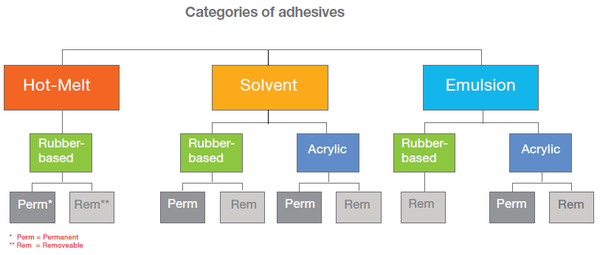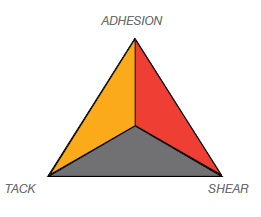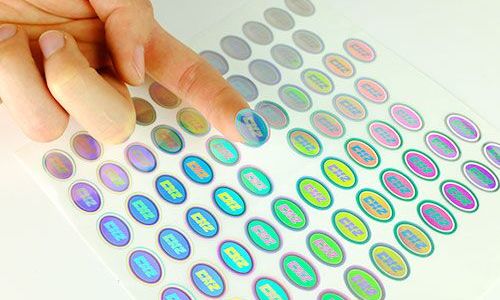Pressure-sensitive adhesives are divided into categories based on the chemical composition of the adhesive: Rubber-based and acrylic adhesives. The chemical makeup of the product is a major contributor to the performance of the product. The typical adhesive properties include Emulsion-based PSAs
Initial Tack - The immediate holding power of the label upon contact with the substrate. A label with high initial tack will grab the substrate quickly. A label with low initial tack will exhibit a low level of adhesion when first applied and may remove cleanly.
Ultimate Adhesion-The ultimate or maximum holding power that the label will achieve as the adhesive penetrates into the substrate. The time required to obtain ultimate adhesion may depend on the stiffness (shear) of the adhesive, the roughness of the substrate and the temperature of the environment. Dwell time can vary from 2 to 24 hours depending on the conditions. Initial tack and ultimate adhesion are not necessarily related.
Shear Resistance-A measure of the internal cohesive strength of the adhesive. The shear of the adhesive is an indication of how soft an adhesive is. A low-shear adhesive (soft) has more of a tendency to flow (resulting in higher initial tack), and has a higher chance that the adhesive will split apart if put under stress. A high-shear adhesive (firm) is less likely to split under stress because of its good internal cohesive strength, and will be less likely to flow (possibly lower initial tack).
Emulsion polymers are commonly used for packaging, labeling, and tapes. Label and Packaging Materials uses emulsion adhesives extensively. The main type of emulsion uses is acrylic polymers. Acrylics function well in both permanent and removable PSAs. For permanent PSAs, acrylics offer high tack and peel strength. For removable usage, acrylic PSAs have good mechanical stability and cohesive strength. Acrylics work across a wide variety of substrates and surfaces.Other types of emulsions include PVA (polyvinyl acetate) and EVA (ethylene vinyl acetate).
Solvent-based PSAs
Solvent-based adhesives are acrylic polymers in petroleum-based solvents.Advantages of solvent-based adhesives are their strength. They provide superior shear and peel strength to water-based adhesives. Solvent-based PSAs tend to have better film formation, and have higher moisture resistance than water-based adhesives.
UV PSAs
These adhesives have the characteristic of being a light-cured acrylic adhesive (thermoset). UV PSAs are non-flamable and solvent free. UV adhesives offer advantages of lower VOCs and better environmental compliance.A key benefit is no carrier solvents are needed which means no drying ovens.
Hot-melt PSAs
Hot-melt PSAs come in several forms:— Styrenic block copolymers (SBCs) are most widely used. These require tackifiers and oil modifiers to achieve the desired adhesive performance.
100% solids
A 100% solids refers to the amount of non-solvent content in an adhesive by weight. Hot-melt PSAs are one type of 100% solid. Low-viscosity polymers that are coated and reacted with radiation to change molecular density/weight are one type, or high viscosity materials that are heated to reduce viscosity for coating purposes and then cooled for final use.
